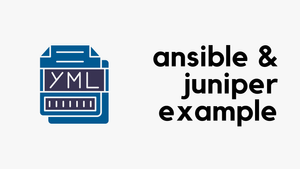When you're working with Ansible, you often come across situations where you need to deal with lists inside of lists. Imagine you have a bunch of servers, and each server has its own set of services to manage.
The subelements lookup plugin is designed to iterate over a list of dictionaries and a specified sub-list within each dictionary. Instead of writing complicated code to dig into each layer, subelements lets you glide through the outer list and then dive into the inner list easily.
What we will cover?
- Subelements syntax
- Subelements example
- What are item.0 and item.1?
- Subelements example with NetBox
Subelements Syntax
To use subelements in your playbook, you write a loop that tells Ansible what main list to look at and which sublist to go through. Here’s what a simple line of code looks like.
loop: "{{ query('subelements', your_main_list, 'your_sublist_key') }}"your_main_list is where you have all your main items (like servers), and your_sublist_key is the name of the sublist inside each main item (like tasks for each server). Ansible will then loop through each main item and its sub-items in turn.
Ansible Subelements Example
Suppose you have the following data structure defined in your playbook.
servers:
- name: server1
services:
- name: httpd
port: 80
- name: sshd
port: 22
- name: server2
services:
- name: nginx
port: 8080This data structure represents a list of servers (servers), and each server has a list of services (services). Each service has a name and a port.
Now, let's say you want to loop through each server and its associated services to create a firewall rule for each service's port. Here's how you can do it using subelements.
---
- name: Configure firewall rules for services on servers
hosts: localhost
gather_facts: no
tasks:
- name: Allow service ports through the firewall
ansible.builtin.debug:
msg: "Allowing {{ item.1.name }} (port {{ item.1.port }}) on {{ item.0.name }}"
loop: "{{ query('subelements', servers, 'services') }}"- We're using the
ansible.builtin.debugmodule just for demonstration purposes to print a message. In a real-world scenario, you would replace this with a module that configures the firewall, likefirewalld,ufw, or a custom module. - The
loopis using thequeryfunction to call thesubelementslookup plugin. - The first argument to
subelementsis the list we want to iterate over, which isservers. - The second argument is the key within each server's dictionary that contains the list to iterate over, which is
services.

What are item.0 and item.1?
In the context of Ansible's subelements loop, item.0 and item.1 are the variables that reference the current items in the loop from the list of sub-elements that you are iterating over.
When you use subelements, you are typically dealing with a list of dictionaries, where each dictionary has a key that contains a list (the sub-elements). The subelements loop gives you each sub-element in turn, along with its parent element.
Here is what item.0 and item.1 represent.
item.0- This is the variable that references the current parent element. In a loop that iterates over a list of servers, where each server has a list of services,item.0would be the server currently being processed in the loop.item.1- This variable references the current sub-element from the list within the parent element. Continuing the above example,item.1would be the current service for the server in the iteration.
Real Use Case with NetBox
I found a perfect moment to use subelements when I was setting up devices in NetBox with Ansible. If you are a network engineer, you might already be familiar with NetBox—it's a great tool for managing and documenting networks.

So, I had this task where each device in my network had a bunch of interfaces. In Ansible, I had a list that looked something like a record for each device. Inside each record, there was another list detailing all the interfaces on that device.
---
devices:
- name: DC-Core-01
site: DC_01
type: Nexus7700 C7706
role: Core
rack: R_01
face: front
position: 10
interfaces:
- name: Eth1/1
type: SFP+ (10GE)
- name: Eth1/2
type: SFP+ (10GE)
- name: Eth1/10
type: SFP+ (10GE)
- name: Eth1/11
type: SFP+ (10GE)
- name: DC-Core-02
site: DC_01
type: Nexus7700 C7706
role: Core
rack: L_01
face: front
position: 10
interfaces:
- name: Eth1/1
type: SFP+ (10GE)
- name: Eth1/2
type: SFP+ (10GE)
- name: Eth1/10
type: SFP+ (10GE)
- name: Eth1/11
type: SFP+ (10GE)
- name: DC-FW-01
site: DC_01
type: PA-3410
role: Firewall
rack: R_01
face: front
position: 15
interfaces:
- name: Ethernet1/1
type: SFP+ (10GE)
- name: Ethernet1/2
type: SFP+ (10GE)
- name: DC-FW-02
site: DC_01
type: PA-3410
role: Firewall
rack: L_01
face: front
position: 15
interfaces:
- name: Ethernet1/1
type: SFP+ (10GE)
- name: Ethernet1/2
type: SFP+ (10GE)Using subelements allowed me to write a playbook that could go through each device and then, for each device, set up its interfaces in NetBox without writing complex loops.
---
- name: "Devices Tab"
connection: local
hosts: localhost
gather_facts: False
vars_files:
- devices_vars.yml
tasks:
- name: Create Device
netbox.netbox.netbox_device:
netbox_url: http://10.10.10.22:8000
netbox_token: MYTOKEN
data:
name: "{{ item.name }}"
site: "{{ item.site }}"
device_type: "{{ item.type }}"
device_role: "{{ item.role }}"
rack: "{{ item.rack }}"
face: "{{ item.face }}"
position: "{{ item.position }}"
state: present
loop: "{{ devices }}"
- name: Create Interface
netbox.netbox.netbox_device_interface:
netbox_url: http://10.10.10.22:8000
netbox_token: MYTOKEN
data:
device: "{{ item.0.name }}"
name: "{{ item.1.name }}"
type: "{{ item.1.type }}"
state: present
loop: "{{ devices | subelements('interfaces', 'skip_missing=True') }}"- Creating the Device - I looped through the list of devices, where each device was defined with its site, type, role, and so on. This loop just went through each device and set it up in NetBox, simple enough.
- Creating the Interfaces - This is where
subelementscame into play. Instead of just looping through devices, I needed to loop through each interface of each device. Withsubelements, I could do this in a single loop by telling Ansible, "Hey, for each device, also go through its interfaces list." And if a device didn't have any interfaces,skip_missing=Truemeant Ansible would just skip it and move on.
By using subelements, I could efficiently create all my network devices and their interfaces in NetBox with a clear, easy-to-maintain playbook.
References
https://docs.ansible.com/ansible/latest/collections/ansible/builtin/subelements_lookup.html
https://www.buildahomelab.com/2018/11/03/subelements-ansible-loop-nested-lists/





